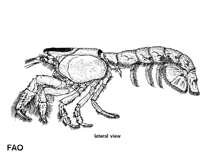Upogebia major (De Haan, 1841)
Japanese mud shrimp
Classification / Names Common names | Synonyms | CoL | ITIS | WoRMS
Malacostraca | Decapoda | Upogebiidae
Environment: milieu / climate zone / depth range / distribution range Ecology
Benthic; brackish. Subtropical; 48°N - 30°N, 117°E - 153°E (Ref. 4)
Distribution Countries | FAO areas | Ecosystems | Occurrences | Introductions
Northwest Pacific: S.E. coast of Siberia, USSR, from Olga Bay southward, Korea, N. China, Kuril Islands, Japan.
Length at first maturity / Size / Weight / Age
Maturity: Lm ? range ? - ? cm Max length : 9.5 cm BL male/unsexed; (Ref. 4)
Short description Morphology
Rostrum ending in 3 teeth, the lateral at the end of a ridge that is separated from the central part of the rostrum by a deep groove; a shallow median longitudinal groove is present in the central part. The lower surface of the rostrum has no spines. Anterolateral border of carapace with a single spine at the level of the eye. First pereiopods subchelate. Dactylus of adult male with 9 to 11 oblique ridges on the outer surface, and with a low tooth in the proximal half of the cutting edge. Two denticulate ridges on the upper surface of the palm. Merus of the first pereiopod with a distinct subdistal anterodorsal spine; coxa of that leg with a spine (Ref. 4).
It has a maximum total body length of 9.5 cm (Ref. 4). It is found in tidal mud flats and it makes Y-shaped burrows in the mud and are filter feeders (Ref. 4).
Life cycle and mating behavior Maturity | Reproduction | Spawning | Eggs | Fecundity | Larvae
Members of the order Decapoda are mostly gonochoric. Mating behavior: Precopulatory courtship ritual is common (through olfactory and tactile cues); usually indirect sperm transfer.
Main reference
References | Coordinator | Collaborators
Holthuis, L.B. 1991. (Ref. 4)
IUCN Red List Status (Ref. 130435)
CITES status (Ref. 108899)
Not Evaluated
CMS (Ref. 116361)
Not Evaluated
Threat to humans
Human uses
Fisheries: commercial
| FishSource |
Tools
More information
Internet sources
BHL | BOLD Systems | CISTI | DiscoverLife | FAO(Publication : search) | Fishipedia | GenBank (genome, nucleotide) | GloBI | Gomexsi | Google Books | Google Scholar | Google | PubMed | Tree of Life | Wikipedia (Go, Search) | Zoological Record
Estimates based on models
Price category
(Ref. 80766):
Unknown.



